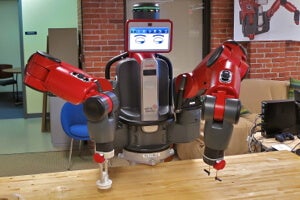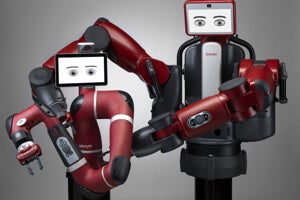Five years ago, industrial robotics was an elitist field. The hardware was expensive and often dangerous for humans to work around. Worse, the only folks who could really play with that hardware were the few computer programmers who could actually speak robot. These barriers—cost, danger and expertise—kept the field about as far away from the mainstream as technology can get.

But a lot has changed since then. If you want to put a date on the start of this shift most people pick 2012, which is when the Boston-based Rethink Robotics introduced Baxter to the world. With a flat screen for a face, a pair of exceptionally dexterous nine-foot arms, and a squat, stout frame, Baxter looks more like a cartoon character than an actual revolution.
But make no mistake, Baxter is that revolution. Specifically designed to solve all three of the field’s largest barriers, Baxter was the moment that robotics went mainstream.
First—and this is arguably the biggest deal—Baxter was the first programmable robot with a user-friendly interface. This means, for the very first time, no expertise required.
Think of the Internet. Invented in the 1970s, for the first twenty years of its existence, the Internet was also expert only. The only people who got to play with it were other computer scientists for the simple reason that you had to be a coder to play.
But in 1993, Marc Andreessen invented Mosaic, the web browser that became Netscape, and toppled that barrier. Mosaic was the first user-friendly interface for the Internet. Anybody who could point and click a mouse could log on. And the result? Before Andreessen came along, there were 26 websites online. A few years after, there were tens of millions. This is the kind of exponential growth unlocked by a user-friendly interface.
This same elitist issue plagued robotics. Five years ago, if you wanted to program a robot, you had to be a computer scientist to do so. But to program Baxter all you need to do is move his arms through the motion you want him to produce and BLAMMO—he’s programmed. It’s a user-friendly interface so simple that a child can program Baxter. It means entrepreneurs can build a business atop his abilities without having to hire a team of experts to help.

It means expertise is no longer a barrier to entry.
Second, Baxter is cheap. His initial asking price is $22,000, making him hundreds of thousands of dollars less expensive than the majority of industrial robots and actually affordable to most startups. Even better, as the pace of robotics is accelerating exponentially, that price is going to continue to drop. In fact, because AI, computer hardware, sensors and actuators—all the major “components” that go into robotics—are all accelerating exponentially, expect the cost of these toys to plummet over the next few years.
Really, though, there’s no need to wait. A few years after Baxter hit the market, researchers at the University of Indiana created a 3D printable robotic controller that can be incorporated into the arms of an older model industrial robot or attached to any of the newer model 3D printable robot designs currently available online. In other words, anyone with access to a 3D printer now has access to cutting-edge robotics.

The third problem Baxter was meant to confront was mortal danger. Go back a decade, and standing in the same room with an industrial robot was a good way to get dead. One errant arm could decapitate a person—which explains why most industrial robots were walled-off from the rest of the work force behind bullet-proof glass.
But taking advantage of the exponential growth in sensor technology, Baxter comes with a 360-degree sonar sensor and a force-sensing system. The combination freezes his motion the moment he contacts flesh. This makes Baxter the first user-safe robot with a user-friendly interface. It means he can work side-by-side with humans and opens up a whole new frontier of cooperative and collaborative possibilities.
Or, at least, that was the initial promise. While human-safe, Baxter was also slow as hell. The problem is that machine vision has been lagging behind other areas of robotic development. Sure, in a well-organized environment with little movement—like an assembly line—Baxter can flourish. But in more dynamic environments, like working alongside humans in a corn field or a busy office, Baxter is still too clumsy to be useful.
But here too we’re seeing staggering progress. Last week, for example, Japanese researchers introduced a robot that can play rocks-paper-scissors against humans and win 100 percent of the time. And this robot wins by watching. Its perfect track record is the result of a built-in high-speed camera and extremely fast reflexes that allow it to read microscopic physical cues—wrist angle, finger movement, head tilt—and (essentially) cheat its way to victory.
Now, important caveat, for this robot to win, perfect lighting conditions and specific background materials were required. It’s not machine vision at real-world speeds quite yet. But it is getting very, very close.
Which means, one of the final roadblocks to robotic democratization—the mainstreaming of industrial robotics—is actually starting to fall.
Image Credit: Rethink Robotics, Steve Jurvetson/Flickr



